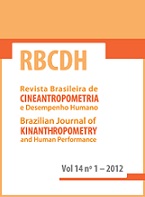Talk test as method to control exercise intensity
DOI:
https://doi.org/10.1590/1980-0037.2012v14n1p114Abstract
The Talk Test (TT) or conversation threshold is a simple and subjective method used to control exercise intensity by a no invasive manner. The basis of this method is that, for many exercise intensities, subjects are not able to maintain comfortable speech and ventilation and other physiological responses are associated to this inability. Thus, some physiological transition thresholds (LTF) can be predicted indirectly by speech difficult. Several studies have explored this alternative by investigating its relationship to physiological and psychophysical variables and evidence of validity for application in distinct populations. It occurred mainly at the 2 last decades which great attention have been given by the scientific community. The aim of this review is to make a discussion about the studies which used the Talk Test to estimate physiological transition thresholds and effort intensities in distinct populations. We present some aspects, such as physiological mechanisms of speech control during exercise, the context of talk test, the methodological alternatives applied, the hypothetical relationship between the talk test and physiological transition thresholds. The search for scientific articles related to this topic was done at the Medline, Lilacs e SportDiscus databases, and by the last studies from our research group. In conclusion, speech production difficult can predict physiological thresholds and identify target zones to aerobic exercise for many populations. However, further studies have to improve the speech protocol for comparison to other physiological and psychophysical variables.



